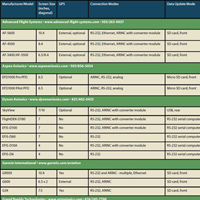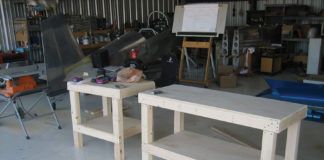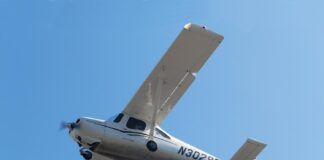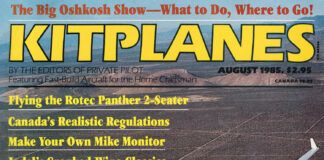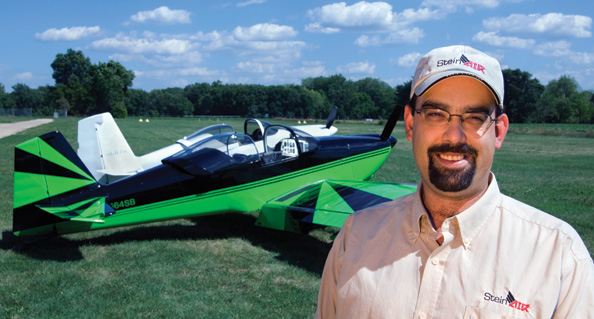
Electronic flight instrument systems have so changed the face of modern Experimental aircraft it’s fairly stunning. Today’s "flat screen" instrument systems brim with capabilities beyond imagination 10 years ago, and with the ever-increasing use of microprocessors and liquid-crystal displays in consumer electronics-from computers to dishwashers, it seems-the price of the raw materials has continued to decline.
As we gaze into the 2011 building season, the landscape in EFIS offerings has not changed much. Familiar companies vie for dominance, while some smaller ones continue to improve product and add features. We think it’s fair to say that none of the companies listed here are on the verge of economic or intellectual collapse. Not to say Lamborghini dealers in places like Aurora, Oregon, and Wyoming, Michigan, are suffering a sudden lack of stock, but what we hear is that the manufacturers have weathered a difficult 2009 and 2010. They’re looking ahead to better days, and preparing themselves for a more robust industry overall.
Enough of the market analysis. In the following pages, we’re going to outline the most popular systems from the leading manufacturers, and try to provide sound purchase information. What we can’t do, however, is put you in front of each system, in an actual aircraft, under the conditions in which you think you’ll be using your EFIS. This is why you need to combine this top-level discussion of the current offerings with as much first-hand experience as you can get-through talking to other builders and pilots about their choices, and, most critically, by standing at the booth in Lakeland or Oshkosh, and actually pushing buttons, twisting knobs. Each manufacturer has an inherently unique way of doing things, and though there are similarities in layout and presentation, there are many more differences.
Hardware Distinctions
Allow us to refresh you on the basic architecture of the modern EFIS. In general, you’ll be dealing with one or two primary components, the display and the AHRS (attitude heading reference system) module. Incidentally, some companies refer to this as the ADAHRS, for air-data and attitude heading reference system, or even other acronyms. Basically, though, the AHRS is made up of the sensors that allow any EFIS to work: MEMS (micro electrical mechanical systems) solid-state "gyros," sensitive pressure sensors for pitot and static, plus some way of determining magnetic north.
There are two current philosophies in AHRS mounting: one includes it in the display itself, integral to the chassis that houses the screen and the computer boards, and the other has an external AHRS box. Some companies, like Grand Rapids Technologies and MGL Avionics, allow you to choose either method depending on the model. All of the original Dynon products have internal AHRS modules, while the new SkyView system depends on one or more external modules. Advanced Flight and TruTrak do only internal AHRS modules, while Garmin’s systems all require remote mounting of the AHRS.
The Ins and Outs
Modern EFISes have evolved to feature myriad input and output formats. We won’t go too deep into that now, but here’s something you should understand. Basic serial ports, sometimes called RS-232 for the computing protocol they run under, are usually called on to conduct basic data streams. For example, the single-axis output from a basic VFR GPS (or a handheld) is almost always an RS-232 signal. Many panel-mount radios include RS-232 connections. For example, the Garmin SL 30 sends its VOR/LOC/ILS course indicator signals out through an RS-232, and a Garmin 400/500-series navigator will output the basic GPS information on the RS-232 line.
However, for more detailed data streams, such as those with GPS steering or GPS vertical commands, you need ARINC 429 serial data capability. For example, the 400/500-series navigators kick out the GPSS and GPSV information only over an ARINC bus, so if you want to shoot the more advanced, vertical-guidance GPS approaches, you’ll need an EFIS that can receive those data signals. Moreover, the 430/530 navigators output the VOR/LOC/ILS signals only through ARINC, so if you want the ILS to show up on your EFIS, you’ll need the ARINC capability. All of the upper-end and more recent EFISes can manage ARINC data from the start, though some of the low-end screens might need an external converter box to do the deed.
What are the other considerations when looking at the EFIS market? Compatibility with an external autopilot is desirable, of course, though the industry is quickly turning toward a tighter package. Dynon, for instance, doesn’t support any external autopilots but instead supplies its own servos that work directly with the EFIS. Others, like the Advanced Flight and Garmin G3X systems have on-screen interface options for guiding and monitoring an external autopilot.
Other nice-to-haves: a backup power source so that the EFIS can be somewhat electrically independent of the rest of the airplane; the option of integrating with an engine monitor (or being one outright with the addition of probes); weather and traffic depiction; terrain and synthetic vision; and Highway in the Sky (HITS) functions.
Advanced Flight Systems
www.advanced-flight-systems.com 503/263-0037
Rob Hickman’s bustling shop has been running full tilt to get the company’s new AF-5600 developed and into the pipeline. Introduced at Oshkosh last year, the 5600 features a 10-inch-diagonal screen with 1024×768 pixel resolution. Eleven push buttons along the bottom of the screen manage soft-menu items, including screen configurations, moving-map functions, navigation selection, checklist access and more. The company also gave the 5600 seven buttons and three knobs along the right edge of the main bezel. The knobs give the pilot a direct input path to such parameters as the baro setting, heading and altitude bugs, and a multitude of other features including map scaling. The seven buttons on the right side are intended to simplify the pilot’s workload: Push the mode button, turn the knob, get the result. No skipping through menus to get to the proper submenu that then activates the knob. In the 5600, synthetic vision, terrain, support for external XM weather and ARINC communications are standard. Prices start at around $7000 for a combined EFIS/engine monitor, according to the company. Delivery is slated for mid-year.
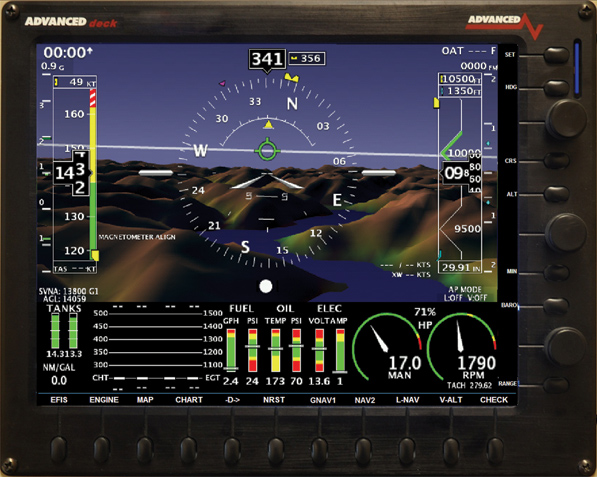
Advanced Flight’s AF-5600.
The company continues to sell and support its smaller-screen systems. Highly modular, the various AFS boxes can be had as 6.5- or 8.4-inch displays and multiple feature configurations. Any of the screens can be a standalone EFIS, an independent engine monitor, or a combined unit with both the EFIS and engine-monitoring hardware built in. To create an AHRS-redundant system, you’d buy one AF-series unit as an EFIS and another as an EFIS/engine monitor, and then network them together so that both screens share the AHRS information (as well as engine monitoring data).
Autopilot connectivity includes the AFS autopilot, a reworked TruTrak DigiFlight II VSGV independent system, though all AFS EFISes will output GPSS and GPSV signals to drive other autopilots.
Stein’s DIY installation rating: AFS also supplies harnesses standard with its systems. With the internal AHRS, EIS (engine instrument system) and optional AOA modules, the installation process is easy. Interconnecting screens is also the easiest on the market via a simple Ethernet cable and the on-board RJ-45 plugs. You will still need to mount a remote magnetometer (as with most systems) along with the optional remote ARINC 429 interface module. The XM weather module is also a breeze to hook up via the aforementioned Ethernet cable. The DIY installation rating would be easy to medium for the AFS units.
Aspen Avionics
www.aspenavionics.com 505/856-5034
Aspen’s broad product line looks ready to expand as we move into the airshow season. (This is written before both the AEA [Aircraft Electronics Association] show and Sun ‘n Fun.) Rumors persist that Aspen is eager to launch a full-screen EFIS that leverages its existing instrument software in a new hardware package. But that’s in the future.
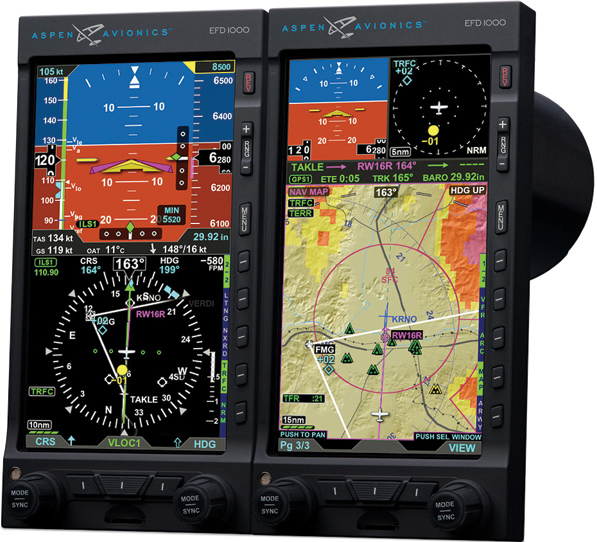
Aspen Avionics EFD duo.
For the moment, Aspen remains a fringe player in the Experimental market, though that’s an upgrade from the early days when the company showed no interest in homebuilts. Part of this is price. The capable Aspen models are considerably more expensive than Experimental-class glass because they’re certified units.
Aspen’s offerings are aligned building-block style. Start with the EFD 1000 Pilot, which has a built-in AHRS module, pitot-static sensors and a remote magnetometer. In essence, this is the base standalone system, and includes just an electronic DG (directional gyro) without HSI (horizontal situation indicator) presentation. To get that, you need to bump up to the EFD 1000 Pro, which includes an HSI and basic moving-map overlay. If you want a full-size moving map, you’ll need to install a second Aspen display, typically an EFD 1000 MFD or EFD 500 MFD. Aspen has recently announced a synthetic-vision update for the Pro EFD due mid-year.
Stein’s DIY installation rating: While Aspen is still relatively cool to homebuilders, the company is more open to installations in Experimental/Amateur-Built aircraft. Physical installation is easy if you are retrofitting a panel with round holes, and their remote magnetometer/GPS module is also relatively easy to install. Wiring is a bit more complex as far as interfaces to other units, but not impossible to do. The DIY installation rating would be considered slightly above medium, but not to the point of being advanced.
Dynon Avionics
www.dynonavionics.com 425/402-0433
Dynon continues to develop its modular SkyView system, adding features and capabilities. In brief, SkyView is perhaps the most modular of all current EFISes. It centers on a choice of display screens, 7- or 10-inch, which contain the main processors, system and nav-database memory, and networking hubs. By placing all of the sensor hardware external to the displays, Dynon was able to get them amazingly thin. The display depth from the back of the bezel to the edge of the cooling fins is listed as 2.14 inches; the whole assembly, including the front-panel knobs, is less than 3 inches thick.
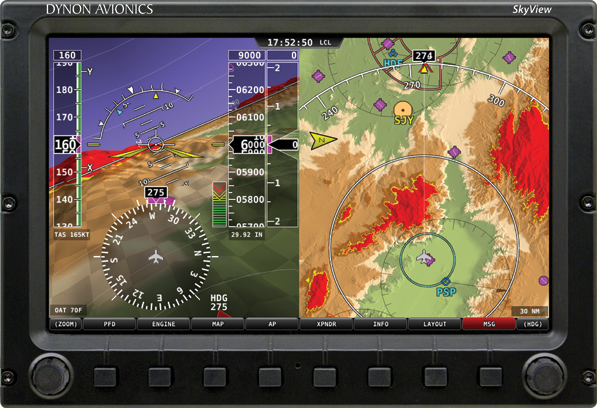
Dynon SkyView.
External modules communicate with the SkyView screens through either Dynon’s proprietary dual-channel SkyView Network or through conventional serial connections. Among the devices on the SkyView Network are the AHRS modules (the MEMS sensors, pitot-static transducers and magnetometer are combined in one case), the EMS (engine monitoring) box, an ARINC 429 converter and Dynon’s autopilot servos. On the serial side, you might find Dynon’s recently introduced remote Mode S transponder or the self-contained GPS receiver. It doesn’t take much imagination to see that remote com and nav modules could be fitted, and it seems likely that Dynon will get weather onto the big, bright displays.
While the SkyView has hogged the headlines, the company continues to build and support the earlier systems, including the EFIS-D10A (fits into a 3.125-inch instrument hole), the D6 (a de-contented D10A), the EFIS-D100 (a 7-inch diagonal display), and the EFIS-D60 (a de-contented D100). All of the legacy boxes can drive Dynon’s autopilot servos, and can be mated with the AP74 autopilot controller box and/or the HS34 expansion box, which brings rotary controls, multiple navigation inputs and ARINC 429 connectivity.
Stein’s DIY installation rating: The legacy products are still among the simplest systems ever to install. The SkyView product line is a bit more complicated with its modular architecture. While installing it in a new build is relatively easy, retrofitting can be challenging as you must route both pitot and static (along with AOA if using it) to the combo AHRS/Compass/Air Data box typically mounted in the wingtip or aft fuselage. The interconnection of various modules utilizes a Network Cable, which is not a standard Ethernet type cable, but rather a nine-wire bundle with standard D-Sub connectors. This can make interfacing various modules (servos, for example) fairly easy. Some parts of the architecture are nice, while others are a bit of a head scratcher, but overall it’s a very nice system to install. Remember when purchasing your SkyView that harnesses and connectors (other than a display harness) are not included standard with the system, but are available from Dynon. DIY install rating of the legacy products would rate very easy, while the SkyView would rate medium+.
Garmin
www.garmin.com/aviation
The big company from Olathe, Kansas, has pressed software development on the Experimental-only G3X aggressively, with recent introductions of synthetic vision, support for its branded TruTrak autopilot and, in the works, HITS. Extensive engine monitoring was introduced in 2010, with kits for a variety of installations all in place by the end of last year. Moreover, Garmin is working hard to have more original-equipment installations.
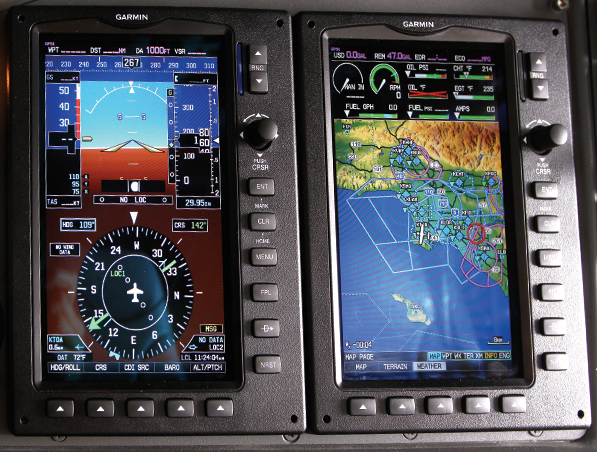
Garmin G3X.
While the Experimental-class G900X (a kissing cousin to the G1000) and the G500/600 twin-panel EFIS will almost certainly end up in some high-end homebuilts, the company’s big push is with the G3X, which we’ve written about extensively; the recent flurry of software updates show that the company wants the system to dominate.
In short, the G3X system is designed around a big silver cube called the GSU that houses the pitot-static sensors, MEMS devices, and all the hardware for engine monitoring. Data from the GSU is sent via CAN-BUS to any of up to three screens. These 7-inch-diagonal, vertical-format screens look like flange mount GPSMAP 696s because, well, they kind of are. But they also incorporate many more serial ports and other features intended to make them work as part of an EFIS. Each GDU display contains a VFR-only GPS, and you can choose GDUs with or without XM satellite weather.
Garmin’s special pricing on the G3X ran out at the end of 2010, so a fully featured system starts at $10,000 for a single screen with weather, with an additional $3295 for each screen and another $1200 for engine monitoring.
Stein’s DIY installation rating: As you may expect, one area in which Garmin blows everyone else away is documentation, both installation and pilot manuals are many times more detailed and thorough than their competitors’. The G3X system is one of the easiest systems to install if you purchase a pre-wired system or a pre-made harness. However, wiring it up yourself can be a medium-to-large challenge for the average homebuilder. This is alleviated by the simple interconnects between Garmin units and the comprehensive GSU that can be mounted in almost any orientation (which makes for easy mounting). The G900X and the G500/600 systems are much more complicated and should be at a minimum pre-wired by the dealer you order from; it is not a beginner type wiring process! The DIY rating for the G3X would be medium, and the G900X/G500/G600 would be advanced.
Grand Rapids Technologies (GRT)
www.grtavionics.com 616/245-7700
Last year, GRT announced the availability of servos to be the muscle that would go with autopilot brains being developed for its Horizon line of EFISes. That project is ongoing, but the current product line is familiar, which we take as a good thing. The company has been conservative in the way it updates and introduces new models, preferring to share development of new items with continuing improvements to the existing line.
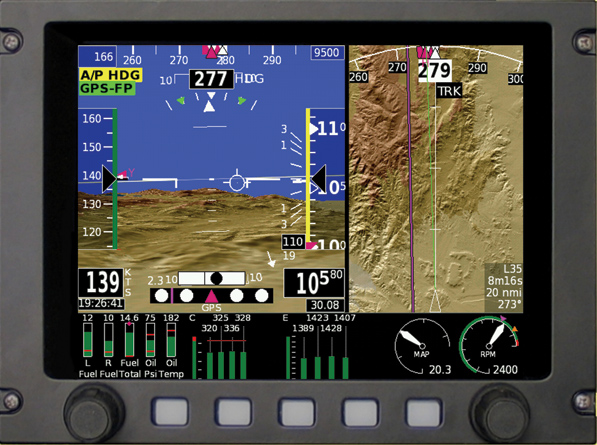
Grand Rapids Technologies’ HX in split-screen mode.
It’s also a simpler line of products, with the company having boiled many permutations down to two, albeit still with many options. The top of the line is the Horizon HX, which has synthetic vision, HITS, extensive networking (serial, RS-232, ARINC 429, Ethernet) standard. The HX is designed to work with an external AHRS box, which GRT has cleverly designed as two products. A single AHRS module costs $3000, but a two-sensor-pack-in-one-box option is only $1000 more, and it provides true AHRS redundancy. (While the sensor packs share a housing, they’re otherwise separate, including independent pitot-static pickoffs. The HX is available in 6.5- and 8.4-inch displays. The HX system has also seen the standard installation of a newer processor, which has more powerful graphics and draws approximately half the power of the previous processor.
The new member of the team is the Sport SX, which has an internal AHRS box. You still need to mount a remote magnetometer, but otherwise the system is self contained. To maintain a price differential to the Horizon HX, the Sport omits a few features and makes them optional, such as ARINC 429 support and synthetic vision. A base Sport is $3000 (including the internal AHRS), but you’ll need to add $1200 for synthetic vision and $475 for an ARINC module, necessary only if you want to have GPSS and GPSV commands available for an external autopilot.
Both EFISes support external weather (add $950), and can be ordered with an engine-monitoring package and backup battery. Grand Rapids’ product line might not seem as flashy as some, and it doesn’t kick out new product every year, but the systems have an excellent reputation. The rumor on the street is that GRT is also working on a large-format EFIS screen; details cannot be confirmed beyond the point of rumor, but stay tuned!
Stein’s DIY installation rating: The GRT installation is simplified with provided harnesses included in the purchase price. The EIS box is still separate, but it uses only one wire to connect to the EFISes; otherwise, it’s straightforward. GRT’s dual AHRS in one box makes installation of the AHRS easy. This is a medium DIY type project.
MGL Avionics
www.mglavionics.com 877/835-9464
This spunky South African company continues to develop its product at a breakneck pace. The Odyssey and Voyager EFISes are now on Generation 2, and feature massively upgraded graphics, finer-resolution synthetic vision and a host of smaller improvements. The Odyssey and Voyager are similar except for screen size, 10.4 and 8.4 inches diagonally. Both feature membrane-type buttons around the screen, a front-load SD card, and seven function or "hot keys" for quick access to certain functions.
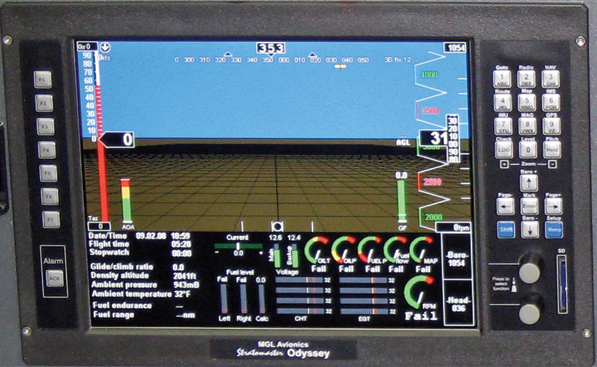
MGL Odyssey.
With this generation MGL is beginning to use more common connectors. Like the SkyView system, MGL’s larger EFISes are highly distributed. The screen holds the main processing power plus inputs/outputs, but the attitude sensor (AHRS) is a remotely mounted box (using PC-standard DB connectors…yay!) as is the compass module. If you want to add engine monitoring, that’s another remote box.
In addition to the Odyssey and Voyager models is the Enigma, a 5.7-inch diagonal system, but the newest of the smaller systems is the XTreme. Featuring a 4.3-inch screen, the XTreme is designed to fit a 3.125-inch instrument hole. We reported on this unit last year, and it continues to make inroads. At a modest price-the version using GPS to derive bank angle is just $1100, and one with a full AHRS is $2360-the XTreme is an excellent choice as a backup to a larger EFIS suite or as a primary instrument in smaller homebuilts.
The company’s top-line EFISes also support internal autopilot functions, and can drive either MGL proprietary servos or the Trio Gold Line servos.
Stein’s DIY installation rating: Indeed, the use of standardized connectors makes the newer generations much easier from an installation perspective. The modular architecture also requires a fair bit of interconnection, but it is not difficult. The smaller XTreme EFIS would be classified as easy to install, while the larger Odyssey and Voyager would rate medium+.
TruTrak Flight Systems
www.trutrakflightsystems.com 479/751-0250
TruTrak’s unusual EFIS continues to evolve, though the basic architecture is unchanged since its introduction. Two models are offered, the EFIS GP and EFIS SG. The main difference is the style of the internal autopilot. The GP’s internal autopilot is simpler, and will follow heading modes or a basic GPS nav mode. The SG includes what is the equivalent of a DigiFlight II VSGV autopilot, which can follow basic heading, simple GPS tracks as well as take GPSS and GPSV steering commands.
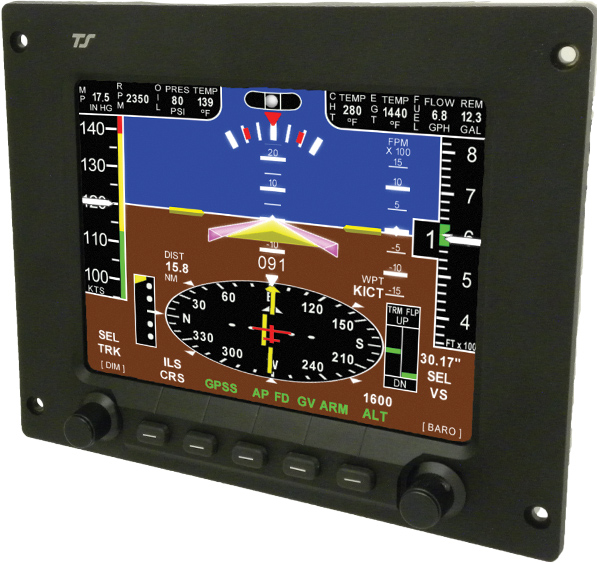
TruTrak SG.
What sets the TruTrak EFIS apart is the company’s philosophy that the display should be much more like analog instruments, hence the round airspeed and altitude dials and "laid down" DG presentation. (Tapes can be selected as an option.) You’ll notice that there is no conventional VSI tape; instead, the pitch portion of the main display is the VSI. In this sense, the TruTrak EFIS is more like its ADI/Gemini standalone instruments in that the pitch presentation isn’t actually pitch but aircraft vertical speed.
TruTrak’s niche in this market appeals to those who want a basic system, have some other device for a moving-map display, and are concerned about making the transition from steam gauges to the tape-style displays used almost exclusively on other EFISes. It helps that a basic TruTrak EFIS starts at $2200 and can add autopilot functions only by purchasing and installing servos. We all appreciate that TruTrak knows its autopilots.
Stein’s DIY installation rating: The TruTrak EFIS rates easiest of all to install, due to the fact that there is no remote compass and no remote AHRS. One bit of genius is that the EIS module, which mounts to the firewall, has shared connectors on both sides. This means you can connect all of the firewall-forward sensors to it outside of the firewall and all of the inside sensors inside the firewall, and then run a simple wire from the module to the EFIS. This makes routing of wires for the engine monitors quite easy. DIY rating is easy.
What to Watch
A couple of new companies, Levil and TL Electronics, have shown product at recent airshows, but we are unaware of any civilian installations. As these pages go out the door, Lakeland awaits. Check our web site, www.kitplanes.com, for news from the show and updates to any of the products discussed here.

